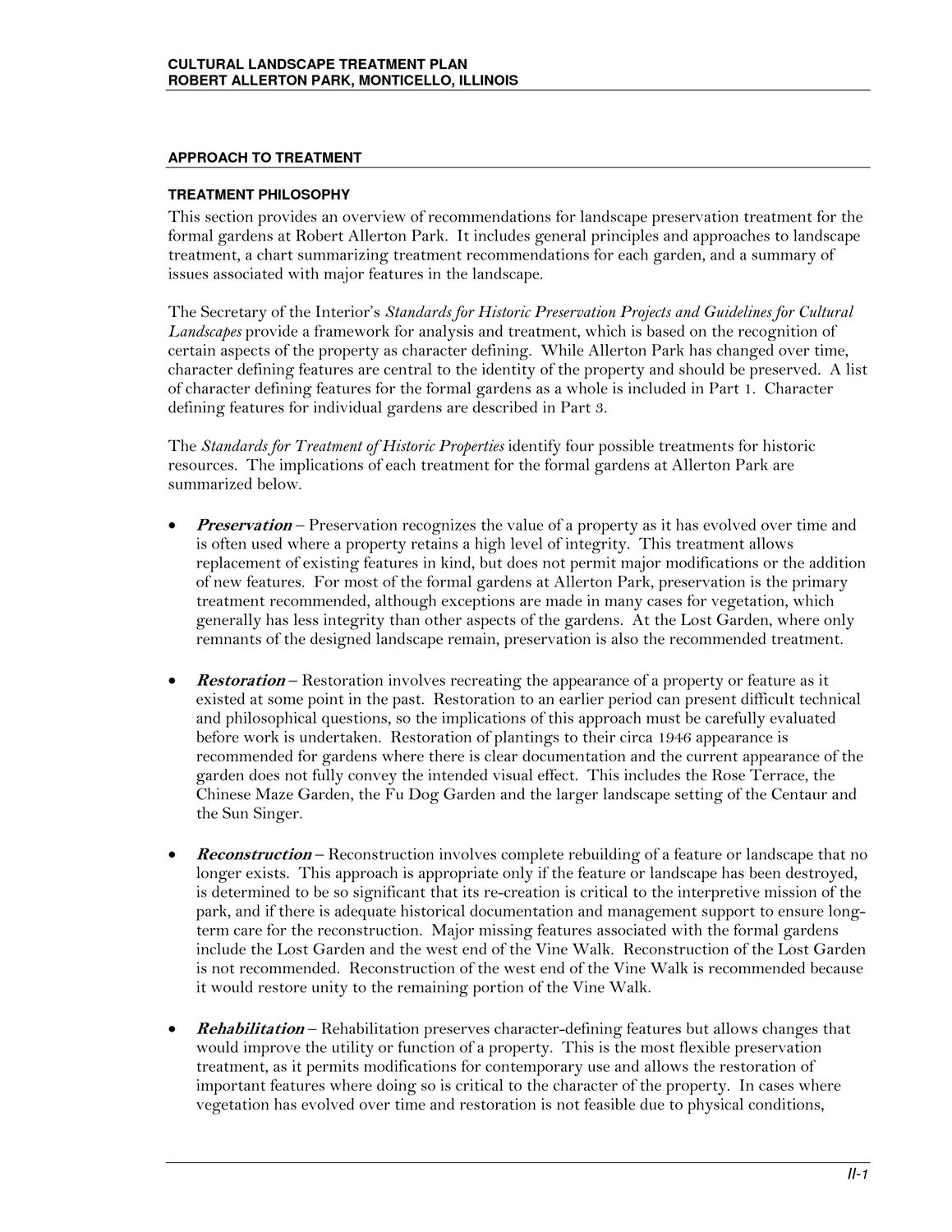Caption: Map of UIUC (2001) (Allerton)
This is a reduced-resolution page image for fast online browsing.

EXTRACTED TEXT FROM PAGE:
CULTURAL LANDSCAPE TREATMENT PLAN ROBERT ALLERTON PARK, MONTICELLO, ILLINOIS APPROACH TO TREATMENT TREATMENT PHILOSOPHY This section provides an overview of recommendations for landscape preservation treatment for the formal gardens at Robert Allerton Park. It includes general principles and approaches to landscape treatment, a chart summarizing treatment recommendations for each garden, and a summary of issues associated with major features in the landscape. The Secretary of the Interior’s Standards for Historic Preservation Projects and Guidelines for Cultural Landscapes provide a framework for analysis and treatment, which is based on the recognition of certain aspects of the property as character defining. While Allerton Park has changed over time, character defining features are central to the identity of the property and should be preserved. A list of character defining features for the formal gardens as a whole is included in Part 1. Character defining features for individual gardens are described in Part 3. The Standards for Treatment of Historic Properties identify four possible treatments for historic resources. The implications of each treatment for the formal gardens at Allerton Park are summarized below. • Preservation – Preservation recognizes the value of a property as it has evolved over time and is often used where a property retains a high level of integrity. This treatment allows replacement of existing features in kind, but does not permit major modifications or the addition of new features. For most of the formal gardens at Allerton Park, preservation is the primary treatment recommended, although exceptions are made in many cases for vegetation, which generally has less integrity than other aspects of the gardens. At the Lost Garden, where only remnants of the designed landscape remain, preservation is also the recommended treatment. • Restoration – Restoration involves recreating the appearance of a property or feature as it existed at some point in the past. Restoration to an earlier period can present difficult technical and philosophical questions, so the implications of this approach must be carefully evaluated before work is undertaken. Restoration of plantings to their circa 1946 appearance is recommended for gardens where there is clear documentation and the current appearance of the garden does not fully convey the intended visual effect. This includes the Rose Terrace, the Chinese Maze Garden, the Fu Dog Garden and the larger landscape setting of the Centaur and the Sun Singer. Reconstruction – Reconstruction involves complete rebuilding of a feature or landscape that no longer exists. This approach is appropriate only if the feature or landscape has been destroyed, is determined to be so significant that its re-creation is critical to the interpretive mission of the park, and if there is adequate historical documentation and management support to ensure longterm care for the reconstruction. Major missing features associated with the formal gardens include the Lost Garden and the west end of the Vine Walk. Reconstruction of the Lost Garden is not recommended. Reconstruction of the west end of the Vine Walk is recommended because it would restore unity to the remaining portion of the Vine Walk. Rehabilitation – Rehabilitation preserves character-defining features but allows changes that would improve the utility or function of a property. This is the most flexible preservation treatment, as it permits modifications for contemporary use and allows the restoration of important features where doing so is critical to the character of the property. In cases where vegetation has evolved over time and restoration is not feasible due to physical conditions, • • II-1
|